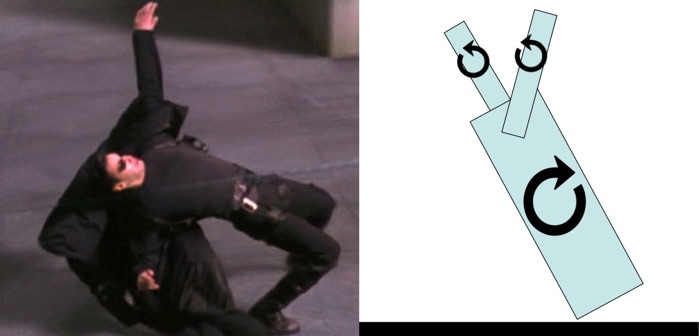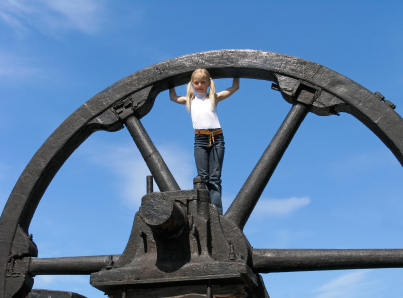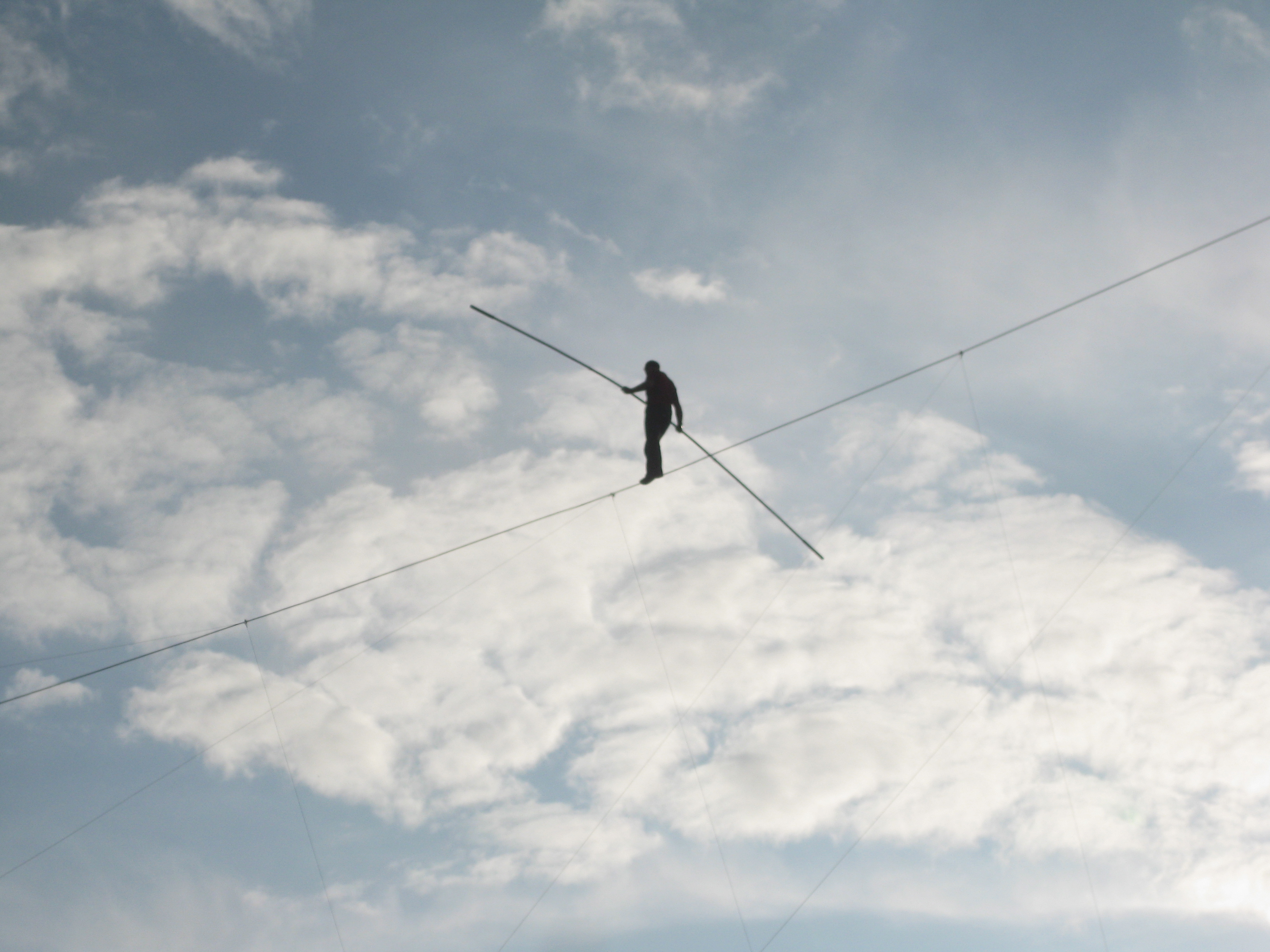The original question was: When I am about to fall backwards I spin my arms up over my head then down . This seems to help in preventing my fall somewhat.
Is this some form of conservation of angular momentum?
Physicist: Actually, it’s some form of conservation of angular momentum.
Assuming you still have at least one foot on the ground, falling over is just a rotation that stops either comically or sadly or both. You start upright and 90° later you’re prone. Everything that moves is subject to the conservation of momentum: if you push something one way, then you’ll be pushed the other way. Similarly, everything that rotates is subject to the conservation of angular momentum: if you rotate something one way, then you’ll be rotated the other way.

Mr. Anderson wants his body to rotate clockwise (to stand back up), so he rotates his arms counter-clockwise. This sort of insight is why it’s so unpleasant to watch movies with physicists.
If you start to fall in some direction, then you want your body to rotate in the opposite direction. Rotating your arms in the direction of the fall causes the rest of you to rotate back to upright.
Someone with gigantic hands and stick-thin-but-long arms would practically never fall over. The more mass you have far from the pivot point (shoulders) the greater the “moment of inertia“. Something with a lot of mass is hard to move or stop (it has a lot of “inertia“). Something with a high moment of inertia is hard to turn and to stop turning. In fact, that’s why flywheels are designed the way they are. Most of their mass is far from their pivot so that they have a high moment of inertia without being ridiculously heavy.
Until we can find the coveted giant-hands-long-arms gene, tightrope walkers will be forced to continue using poles to keep their balance. They use their pole to keep balanced in exactly the same way the rest of us ground-dwellers use our arms. If you can believe it, the search for this gene isn’t a priority for most geneticists.
The same trick we (humans with arms) use to keep our balance is the same trick that space craft use to rotate in space. Here on the ground we can push off of things. If you want to face a new direction, use your feet to push on the ground and voilà: a new vista lays before you (or another wall if you’re inside).
However, space is notable for its remarkable dearth of stuff. There’s nothing in space to push on, so spacecraft engineers (notable for their remarkable plenitude of cleverness) literally provide stuff for their spacecraft to push: flywheels. By turning a tiny flywheel clockwise a lot, the rest of the spacecraft turns counter-clockwise a little.

Turn a wheel in space, and turn yourself. These are from the Hubble space telescope. Hubble would be a whole lot of pointless if it couldn’t point in more than one direction, but it also can’t pollute the space around it with rocket exhaust (avoiding gases is why it’s up there in the first place). So: flywheels.









Gravity on earth 9.8N, is this a common name for many forces???, what is real force on Nowton ,without other force?
We’ve seen birds do it. So, at that crucial moment, what the hell, just try it!
Sure. It is absolutely true that we try to regain our desired position by incorporating some form of conservation of angular momentum. But why? I thought it over.
It is because we are children by and of physics and, being a natural part, built only to take advantage of how and where nature has grown us. We can subconciously calculate what to do incredibly quickly when we need to. It is called instinct.
We first learned motion a long time ago in the sea. All the successful neurons still thrive pre-programmed at our primitive stem core. When we fall, we automatically began to swim straight again. Our sea-fins have become arms.
Whereas the weight (mass) of water once allowed us to take advantage of Newton’s 3rd law in the distant past (“For every action, there is an equal and opposite reaction”) we no longer have that advantage, but do have more momentum. The reasoning is we now have heavier, more massive “fins”. Incidentally, when our fins were still thin and light, part of our brotherhood learned to fly. But really, birds just swim through the air with long, light fins.
And what do we do, when our primitive brain runs amok during sleep? Why we still dream of swimming above the trees, slow and graceful, while a more modern braincell warns us we must not go so slow, nor leap so far as to fall. A lot of broken bones paid for that newer cell.
By leaps, our instinct has guided us to the secret laws of nature ever since. Somehow the eurekas are already written inside us.
I am trying to work out the force of falling backward
The scenario
Person A 6ft 3 weighing 65 kilos standing on a level flat concrete footpath is punched in the face and immediately unconscious
Person B punching is 6ft 2 weighing 95 kg
At what force does person A hit the ground ?
@ Dianne,
Your question is not so simple. Rather you might ask how to calculate what the average tilt impact of the entire falling body may be. Of course the head will usually fall the furthest and hit with greater impact than the back of the heels for instance.
First the velocity of impact is calculated by the distances to ground and the acceleration of gravity. Then finally introducing the kinetic energy formula by the masses vs calculated velocities involved will reveal the true forces and energy(s) of impact. The flexible body may have to be calculated as though a sack of various size potatoes has fallen over, each potato having it’s own small impact added to the whole.
Interestingly, the force of the punch will have no overall mass-adding effect to total ground impact because we may generally consider this force at right angles to the fall impact. But consider if, just before impact, the body might be rotated to exactly 90 degrees from a very vigorous punch, then stop in mid-air. Then all parts (feet, head etc) would fall the same distance with equal acceleration as though the body were held level, prone above the ground, and dropped from wherever height it’s actual center of gravity resides. In reality, to further complicate things, the body would continue to have some rotation from the punch which might mean the head would take a greater portion of the ground impact and the feet initially far less than their individual mass merits. In turn there would certainly be a bouncing effect and a short-lived head/foot “rattling” as decreasing impacts oscillate head-to-foot a bit before they settle down.
If the body is more likely rotated somewhat more or less than 90 degrees, depending of the force of the punch, some parts will at least again fall further than a simple tilt, a tilt-over fall which would be experienced in a more gentle fall-over from a simple standing position such as fainting.
But suppose you wish to know just the cranial ground impact, instigated by an insignificant small punch as in a gentle tilt-over. Still, other info would be needed. Does person “A” @ 65 kg have a large head and small feet or vice-versa? Then just how did the fall progress, and was the body perhaps pre-bent by the punch or some other reason? Did the person, with what we may assume has a lumpy, flexible body, fall in such a manner that the shoulder blades hit first for example? If so, there may be a whiplash effect just before head impact, that causes the head to be accelerated faster than the usual acceleration of gravity.
The best practical solution would be to have a 65 kg body fall similar to the exact situational query and measure the various momentary impact points with recording devices similar to bathroom scales. Ideally there would be at least a cell-phone video of the original fall to assist replicating the many conditions as closely as possible. In the end it would still all be a loose estimate unless a forensic expert could somehow calculate impact very closely by precisely inspecting tissue damage.
Wes
…